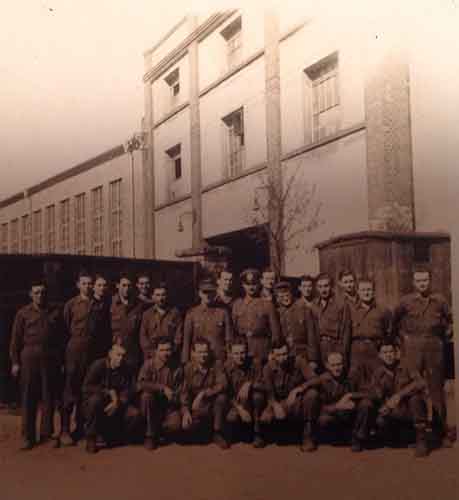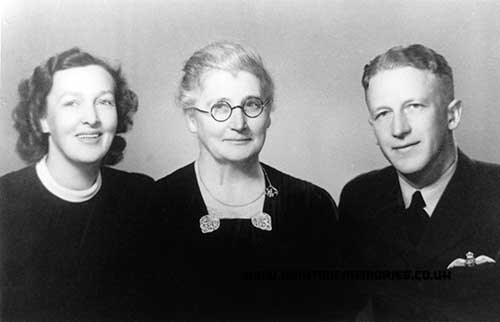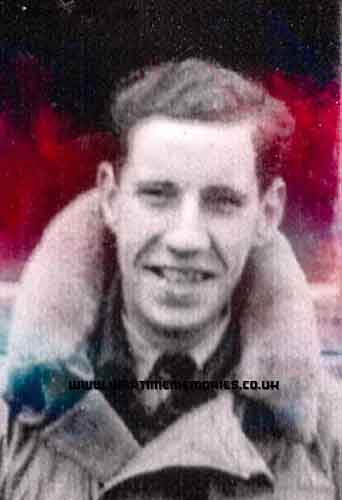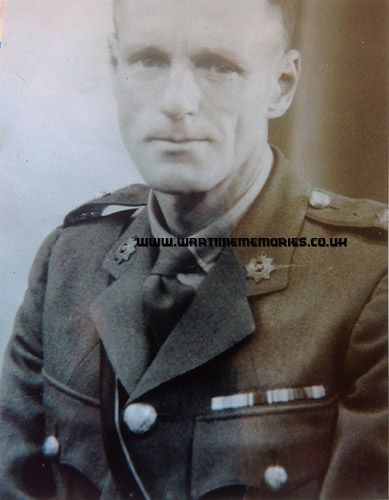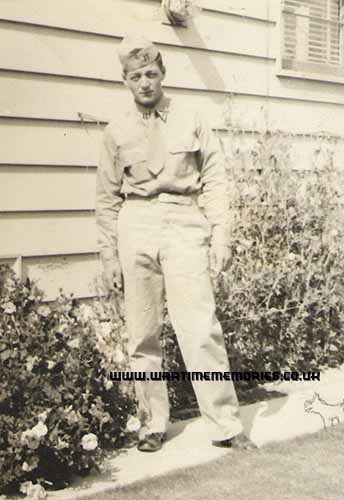|
|
|
DD Maud . British Army DD Maud served with the British Army. I have his unissued dogtags, made in preparation for deployment to the Far East and would love to get them home to his family. I am happy to cover all costs. If you are a family member or can put me in touch with them please get in touch. Update: Unfortunately The Wartime Memories Project has lost touch with Dan, his website, facebook page and email have all ceased to function. But if you can add any details about the person listed, please use the add to record link below.
|
F/S G. M. Maude . RAAF 138 Sqd.
|
Walter Robert Maude . British Army Royal Field Artillery
|
Sgt. Harry Maule . Royal Air Force 408 (Goose) Squadron from Alloa Harry Maule volunteered as he wished to join the Air Force. He ended up in 408 Squadron and completed a full tour of operations and survived the war.
|
J Maull . British Army J Maull served with the British Army. I have his unissued dogtags, made in preparation for deployment to the Far East and would love to get them home to his family. I am happy to cover all costs. If you are a family member or can put me in touch with them please get in touch. Update: Unfortunately The Wartime Memories Project has lost touch with Dan, his website, facebook page and email have all ceased to function. But if you can add any details about the person listed, please use the add to record link below.
|
Sgt. G. F. S. Maunders . RAF ABC operator 101 Sqd. (d.3rd Nov 1943) Sgt G.F.S Maunders was the 8th crew member (ABC operator) of Lancaster LM635 SR-H was killed on the 3rd of Nov 1943 when the aircraft was shot down, flying from Ludford Magna en-route to Dusseldoft was shot down. He is buried in the Rheinberg War cemetery.
|
Andrew Maurice Maundrill . British Army Royal Armoured Corps from Yorkshire Andrew Maundrill served with the Royal Armoured Corps British Army. I have his unissued dogtags, made in preparation for deployment to the Far East and would love to get them home to his family. I am happy to cover all costs. If you are a family member or can put me in touch with them please get in touch. Update: Unfortunately The Wartime Memories Project has lost touch with Dan, his website, facebook page and email have all ceased to function. But if you can add any details about the person listed, please use the add to record link below.
|
Pte. Henry K. Maus . United States Army 106th Infantry from Arma, KS My father, Henry Maus, was in the Artillery Group of the 106th Infantry. He was taken as a Prisoner of War during the Battle of the Bulge. He was taken to Stalag 4B.
His story was that he and a few other Americans had talked a farmer into piling horse manure near the fence of the place where he was held. He and the others jumped from a second story window, over the fence where the pile of manure broke their fall. After escaping, they ran and went into hiding in the forest. After two days they ran into a group of American soldiers coming down the road. The soldiers told them that the war had just ended!
|
F/Sgt Douglas Kenneth Mavleod . RCAF 419 (Moose) Squadron (d.20th Feb 1944) F/Sgt Douglas Kenneth Macleod J19971 was a pilot based at Middleton St George now Teeside airport and flew Halifax's from this base for 419 RCAF Moose Squadron which included VR JD 114 V and was KIA aged 22 on 19/20th February 1944.
|
L/Cpl. Andrew Corbett Mavor . British Army Royal Signals from Glasgow My father, Andrew Mavor, flew into Normandy in a Dakota on D Day. He was a signals para assigned to the Canadian troops trained in the UK. The plane was hit. They went down over Villiers sur Mer and Gonville, Normandy. The survivors found themselves in enemy held territory with German troops all around. My dad stayed free for 5 days and then was captured and marched and trucked around until arriving at Stalag 4b in August. While there he met a magician who taught him well.... my dad later became a member of the Magic Circle. He was freed by Russian troops on 23rd of April 1945.
|
A Maw . British Army Duke of Wellingtons West Riding Regiment A Maw served with the Duke of Wellingtons West Riding Regiment British Army. I have his unissued dogtags, made in preparation for deployment to the Far East and would love to get them home to his family. I am happy to cover all costs. If you are a family member or can put me in touch with them please get in touch. Update: Unfortunately The Wartime Memories Project has lost touch with Dan, his website, facebook page and email have all ceased to function. But if you can add any details about the person listed, please use the add to record link below.
|
KW Mawby . British Army Royal Armoured Corps KW Mawby served with the Royal Armoured Corps British Army. I have his unissued dogtags, made in preparation for deployment to the Far East and would love to get them home to his family. I am happy to cover all costs. If you are a family member or can put me in touch with them please get in touch. Update: Unfortunately The Wartime Memories Project has lost touch with Dan, his website, facebook page and email have all ceased to function. But if you can add any details about the person listed, please use the add to record link below.
|
J Mawdsley . British Army J Mawdsley served with the British Army. I have his unissued dogtags, made in preparation for deployment to the Far East and would love to get them home to his family. I am happy to cover all costs. If you are a family member or can put me in touch with them please get in touch. Update: Unfortunately The Wartime Memories Project has lost touch with Dan, his website, facebook page and email have all ceased to function. But if you can add any details about the person listed, please use the add to record link below.
|
F/O. William J. Mawdsley . Royal Australian Air Force 23rd Operational Training Unit from Nathalia, Victoria, Australia (d.2nd June 1942) Bill Mawdsley was born in 1912 and became a school teacher. In early 1941 he took part in No 9 Course, No 4 Empire Flight Training Scheme at Mascot New South Wales. He was then posted to "Y" Depot, Halifax, Canada leaving his wife Lorna at home in Australia.
After arrival in England he was completing his training at the 23rd OTU at Pershore when he was sent with his crew as part of the second "Thousand Force" night raid to Essen in Germany. He was in command of a Wellington 1c bomber - No R1266-GZ and took off from Pershore at 23.05 and did not return from the mission.
Nothing was known of them until 8 years later when Dutch bulldozers excavated the plane with its dead crew. They had been shot down over Holland and crashed near the Terwindt Brickyard at Kerkdriel (Gelderland) on the west bank of the Maas and and some 13kms west-south-west of Oss in the neighboring province of Noord Braleant. It was thought that two of the crew had perhaps bailed out but not survived. He is buried with his crew at Uden War Cemetery.
|
L/Sgt. Alfred Horace "Horace" Mawer . British Army 3rd Battalion Coldstream Guards from Lincoln My Uncle Horace Mawer wrote me a letter for a school project in 1983 about his part in the Battle of Monte Cassino. It was the first time he had talked about his wartime experiences. I recently found the letter for my own son and have transcribed it below.
Gustav Line.
The Battle for Monte Cassino 5-14th November 1943
201 Guards Brigade
- 3 Battalion Coldstream Guards,
- 2nd Battalion Scots Guards,
- 1st Battalion Grenadier Guards.
To give you some idea of its height, there was a mule track running around it on the lower slopes, where it was possible to get a jeep so far.. then it used to take stretcher bearers something like 4 hours from our positions at the top to get to the mule track.
On the way up the village of Calabritta had to be taken. I think the start time was 10 o'clock soon the night of 5th Nov. The opposition was not that heavy but there were minefields all over the place. We had casualties mainly through mines, all opposition was now killed off or taken prisoner. One of the prisoners was to lead us through further mined areas with a gun in his back. That seemed to pay dividends as he led us safely through.
As dawn broke on the morning of Nov 6th we laid low all day. We were shelled and mortared all day as the whole area could be seen from the monastery in the town. As it grew dusk we set off on the last part of the climb to the top of Cassino.
Just imagine full kit and gun, it makes the Falklands fiasco look like a sunday school treat. It was raining continuously day and night. (editors note this would have been written in 1983-4).
You couldn't dig the ground it was solid rock, so we had to collect all the loose rocks one could find and build a Sanger.
(The place being shrouded in mist most of the time to make it more freezing)
The way we lived for the next 8 days and nights does not bear thinking about; no water or just enough to make a brew of tea with a tablet (solid fuel no smoke). Our tins of stew were also eaten straight out of the cans.
This was one of the most wretched and futile battles I can recall - counter attacked every night, sometimes twice a night, they, the Germans, used the mist..we had the advantage we were throwing our grenades down hill and inflicted heavy casualties as the moppers up found some weeks later.
The Grenadiers took Barearse Ridge a feature to the right, 2 of their companies hung out for 3 days and nights with appalling casualties but managed to hang on their objective, the wounded not being abe to be treated until the night of 9th Nov.
We then took over their formation on Barearse Ridge, with the Scots Guards to our right again and where my Sanger was positioned I could see our own shells falling straight onto the Jocks, everyone was angry and shouting at the Duty OPs. Like he said, it was a difficulty task if we were to have his support owing to the place where the guns were positioned.
The Germans were now pouring in reinforcements.
It began to look as if our efforts had all been in vain - our move out from the Anzio bridgehead and onto the town and monastery. German snipers were being effective in pinning our supply lines (i.e mule trains to forward companies). My company was twice attacked in daylight and the Germans driven off successfully.
The order came through to withdraw (13/14) under darkness, everything that couldn't be carried down had to be smashed, rum, rations, gun ammo, complete withdrawal.
We rested our legs and as we looked across the valley we could still see the German shells landing on our positions that we had paid dearly for.
Again we took these objectives on Dec 2nd. 12.5 hr climb with full kit, launched over the line regiment .?? on 11th Dec. Moved forward to the right of Cassino for a break.
Footnote:
Thousands of holidaymakers every year are taken on conducted tours of Sorrento and Naples and when they leaf through the markets never think of this invisible memorial to the taken.
Excuse scribble.
Love Horace.
|
Lt/Capt Jesse Frederick Mawer . British Army 279 GT Coy Royal Army Service Corps My father served as a lieutenant, then captain, with the Royal Army Service Corps during WWII from 1940/41 until 1946. I have a collection of photographs of him in the Middle East in 1942/43 in Baghdad (279 GT Coy RASC), Damascus, Cairo, Jerusalem and then in Holland and Germany in 1944/5.
|
ERM. Walter Albert Mawson . Royal Navy from Newark, Notts
|
Flt.Sgt. Frank Maxted . Royal Air Force 354 Squadron from Eyam Derbyshire (d.11th Mar 1945) Frank Maxted was aircrew on a Liberator, killed in action by enemy aircraft, lost at sea off Singapore. He was 19 years of age.
|
Eric Maxton . Royal Air Force 460 Sqd.
|
Murray Maxton . Royal Air Force 460 Sqd.
|
Pte. Garth Ewart Maxwell . Australian Army from Blackall
|
2nd Lt. George Barton Maxwell MC.. British Army Royal Army Service Corps George Maxwell was awarded the Military Cross on 1st of October 1918 after action at Sequehart, a small village between the St Quentin Canal and the Hindenberg Line.
He was later a chemist, and served as Lt Col in the RASC responsible for fuel quality during the invasion of Italy in WW2.
|
PFC. James Maxwell . United States Army 2nd Btn. 415th Infantry from Claymont, Delaware, United States My father James Maxwell was an assistant machine gunner in F Company, 2nd Battalion, 415th Infantry. He requested to switch places with the gunner, PFC Needles, on 31st October 1944, while preparing a defensive position. An enemy artillery and mortar barrage commenced on the same day. My father was wounded and PFC Needles was killed. Some soldiers stated they were going to leave him next to a tree and come back for him later, but my father was afraid the Germans would get him. With the aid of a medic he made it to the Battalion Aid Station. His wound was in the left shoulder blade area, and he also suffered a collapsed lung in addition to shrapnel in his lung. For many years, he kept the shrapnel in his Purple Heart case. He recovered in England and Camp Pickett, Virginia.
He graduated from the University of Delaware, where he was President of Sigma Phi Epsilon. He worked as GE Sales Engineer for over 30 years and passed away suddenly in 1983.
|
Pte. Ronald Douglas Maxwell . Hong Kong Volunteer Defence Corps from Kowloon, Hong Kong (d.23rd Dec 1941) Ronald Maxwell was the son of Mrs C.E. Maxwell of Kowloon, Hong Kong.
He was 22 when he died and is buried in the Hong Kong St. John's Cathedral Grounds.
|
Sgt. Thomas Maxwell . Royal Marines Guncrew HMS Cairo from Newtownards, Co. Down, Northern Ireland My grandfather, Thomas Maxwell joined the Marines at 14, boy service. He saw service on HMS Cairo, Kenya, Caroline & HMS Indefatigable. He was in pre war Palestine then Norway, Dunkirk, Russian convoys, Crete, Malta, Dieppe, Italy, Burma and other units 45, 44 commando att sbs. He was badly wounded in Burma headshot by a Jap sniper. If any vets of 44 cdo knew him I would like to hear from them.
|
PFC. William Martin Maxwell . US Army 422nd Infantry Reg. from Lapwai, Idaho My father, William M. Maxwell, served with the 106th Infantry Division. 422nd Infantry Regiment was captured on 16th of December 1944. He was interned in Stalag IX Bad Orb Germany until he repatriated on 2nd of April 1945. Since my parents divorced when I was very young I only found out this information recently through research. I would appreciate any additional information about my father.
|
Stkr. William Stewart "Scotty" Maxwell . Royal Navy HMS Europa from Stirling, Scotland
|
Gnr. William Edward "Max" Maxwell . British Army Royal Horse Artillery from India My father, William Maxwell, was born into an Anglo-Indian family in 1909 in Rewaree, North India. His father was an engine driver on the Indian Railways.
His early life was spent travelling around with his parents and siblings wherever his father was working, but at the age of eight he and his two sisters were orphaned and they were sent to an orphanage in Orissa, Eastern India, where he stayed until the age of eighteen. Life had been very harsh there and one of his sisters died at the age of fourteen.
He joined the Royal Horse Artillery in Meerut as a young man, serving seven years on the North Western Frontier before the outbreak of WW2 in 1939, when his regiment was sent back to England. This was the first time he had ever been to the UK.
My father took part in the British Expeditionary Force to France and was repatriated from Dunkirk. After this, he was sent to North Africa, where he was captured by the Italians at Gazala in 1942. He was initially transported to a camp in Capua, near Naples, then transferred to Campo 53 at Sforzacosta in the Marche region. I knew little of this period of my father's imprisonment until I received his war records and was able to do my own research.
My father died from injuries and illness in 1950, as a result of being on a Death March in the winter of 1944/5. I was three years old at the time of his death, so was never able to speak to him about his life.
After the Italian armistice, he became a prisoner in German hands in 1943, arriving by cattle truck at Stalag VIIIB in October 1943 and then being transferred to Stalag 344 (Lamsdorf) in 1944.
In the bitter winter of 1944/5 the Germans, fearing the advance of the Russians from the East, emptied the camps and forced all the prisoners to march westwards. Conditions on the march were appalling. Men died from dysentery or exhaustion, or were shot by their captors and their bodies flung into ditches. The prisoners had virtually no food and resorted to eating handfuls of snow to quench their thirst or tearing up grass to eat. They would sleep in barns, and sometimes pigsties, but if there was nowhere else, they would have to sleep on the frozen ground. They marched on for four months through one of the bitterest winters in years, across Poland and Germany, until eventually, they fell into the hands of the Allies, approaching from the west.
My father, gravely ill by this time, was airlifted back to Britain in April 1945 and sent to a hospital in Ashridge, Berkshire, where he was nursed back to health. This was where he met my mother, Joyce, who was a patient in the civilian wing of the hospital. They met at a dance organised by the hospital authorities to celebrate the end of the war and by the end of 1945, they were married.
They settled down to married life and by 1948 had two children, myself and my brother, David. When my mother was expecting their third child, my father became very ill and was admitted to hospital, where he died from kidney failure, directly attributable to his treatment as a POW and his experiences on the Death March.
He died aged 40, in April 1950 and my sister was born two months later, in June. Mum was only twenty-six years old and also profoundly deaf. However, she managed to bring up three children single-handedly, totally against the odds and later in life, was a Founder Member of the War Widows' Association of Great Britain, for which she received the MBE.
|
Gnr. Alfred Allan May . British Army 61st Anti Tank Regiment Royal Artillery from Copmanthorpe, York (d.27th October 1942)
|
|


